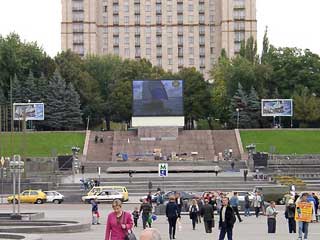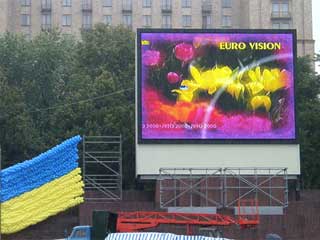Large outdoor LED screen in Kiev
One of our colleagues visited Kiev (Ukraine) during summer vacations and noticed a large outdoor LED screen that was installed on the central city square - Maidan Nezalezhnosti (Independence Square). Since he always thinks about work even on vacations, he made photos of the LED screen and sent them to our Chief Editor. On arrival to Kiev we immediately went to the central square on the Kiev's Broadway called Kreshatik. The aim of our visit can be seen from far away: it's a large outdoor LED display screen by “EuroVision”.
Part of the time outdoor LED screen was displaying advertising of the owner company “EuroVision”. We talked to the service personnel, wrote down contact information and started making photographs. Only when we had enough photo materials, we went to the headquarters of “EuroVision” in Kiev to interview the Director Mr. Kang Den Sick.
We found out that the installation of the outdoor LED screen began at the end of 1999 and the display was commissioned (after testing and adjustments) in April 2000. So, it took 4 months to test and tune the screen.
The large outdoor LED screen in Kiev is capable of displaying computer animation and video images (commercials on BetaCam and CD formats) as well as of TV broadcasting and live video. These functions were used for broadcasting soccer games of “Dinamo Kiev”, European soccer championship 2000, address of Bill Clinton during his visit to Kiev, concert show of the Ukrainian singer Natali and other similar events. While we were in Kiev, the preparations were under way for public presentation of Ukrainian Olympic team.
 |
 |
| Large outdoor LED screen in Kiev | |
Mr. Kang Den Sick told us about one peculiar feature of this new generation of full-color outdoor LED screens: automatic control of louvers on LED modules. The screen operates from 9 a.m. to 11 p.m. without sound. The sound is switched on weekends and holidays from 12 a.m. to 9 p.m. Potentially the LED screen may work in “24/7” operational mode. The projected life of the LED screen is 4-5 years with daily 14-hour operation.
According to Mr. Kang Den Sick, he decided to install this outdoor LED screen in Kiev after successful launches of similar projects in Korea, USA, India, Indonesia and other countries. He told us that Soul has practically no static advertising boards by now because they were replaced with outdoor animation video displays. The only surviving static outdoor signs are the large informational board along Soul's highways that remind drivers to drive cautiously.
According to Mr. Kang Den Sick, in spite of the new technology and high price of such systems (we involuntary gasped at the figure: the outdoor LED screen was sold for almost $2 million which is approximately $25-30.000 per square meter), the advertising time is sold quite successfully in South Korea and other countries. The outdoor advertising LED screens not only return the investment but soon become profitable.
Large companies have realized the efficiency of these electronic systems and start investing into outdoor electronic (digital) advertising. For example, in India “Coca-Cola” bought one third of all advertising time on a large outdoor screen. As a result, the initial investments were returned already in six months after installation.
In Kiev as in many other cities around the world, part of the time on the advertising outdoor screen is given to city authorities for broadcasting cultural and informational announcements. This must always be taken into account when potential customers calculate the financial efficiency of a screen. Unfortunately, “EuroVision” is yet unable to sell all the time on its advertising screen. Mr. Kang Den Sick blames a certain conservatism of Kiev advertisers: people are not yet confident in the efficiency of electronic advertising and do not want to spend money on what they believe to be a “technological experiment”.
However, there are cases (for example, in Indonesia) when large electronic outdoor screens became profitable only by the second year of operation after the advertisers “got used” to new and more effective advertising carriers.
According to our experts, somewhat ineffective operation of the Kiev outdoor LED screen is a result of its wrong placement. It faces the square and cannot be seen by motorists. Moreover the trees that frame the perimeter of the central square hinder the view for pedestrians. As a result, main traffic and pedestrian flows are moving parallel to the LED screen. Even if people turn their heads to watch the LED screen, the “contact time” remains minimum. This is not the ideal parameter for advertisers who prefer potential viewers to spend some time attentively watching the outdoor LED screen.
Such placement of the outdoor LED screen is better suited for broadcasting cultural, political and sport events rather than effective commercial advertising. During our conversation we found out that this screen is the new generation of outdoor LED displays, the first such screen in Europe. These systems were developed in South Korea and went into production in late 1999.
These are our short conclusions:
- The LED display screen in Kiev has dimensions of 10.5x7.2 meters;
- The resolution is around 288x192 pixels;
- It consists of 18 horizontal and 12 vertical LED modules;
- LED module size is around 60x60 cm;
- Each LED module houses 16x16 pixels;
- Pixel pitch is 3.75 cm or 1.5 inch;
- Each pixel consists of 16 super bright LEDs (apparently 2 Red, 12 Green and 2 Blue);
- Number of color is 16.7 million;
- Installation and tuning takes about 2.5-3 months;
- The horizontal field of view is about 60 degrees;
- The LED display screen is capable of “24/7” operation;
- The approximate cost is $2 million.
Our comments:
- Such long period of installation and adjustments (4 months) sounds a little suspicious;
- The pixel structure (16 LEDs) is excessively complex. Similar pixel structure and fast aging of LEDs on some displays in Latin America are believed to have caused some maintenance problems after 1.5-2 years (blue color disappeared, the image quality became non-homogeneous). In general, the rule holds true: “the more complex is the pixel, the higher is the non-regularity in image quality”;
- The TV and computer screen resolution ratio is changed. On the Kiev outdoor LED screen the horizontal VS vertical ratio is equal to 288/192 or 3/2; while TV signal (PAL, SECAM and other formats) and most computers (320/240, 640/480, 800/600 etc.) maintain a 4/3 ratio. This results in distortions during conversion of TV images and video recordings that were prepared with universal standard resolution or demands more expensive conversion equipment;
- The placement of this LED screen violates some general rules of outdoor advertising;
- Such huge square as Maidan Nezalezhnosti in Kiev obviously needs a bigger display to make it more effective during public broadcasting;
- The LED screen price is very high.
The future will show how this large outdoor LED screen will operate in varying weather conditions since the technology is quite new and is not proven by long-term operation. Whatever the case, the installation of such large advertising display in Kiev confirms the existing tendency to place large electronic (digital) screens in towns in spite of their high price. They illuminate cities, enliven night life of cities and provide additional and much needed informational and advertising resources to city authorities.





